Intel To Wind Down Optane Memory Business - 3D XPoint Storage Tech Reaches Its End
by Ryan Smith on July 28, 2022 5:00 PM EST- Posted in
- Storage
- Intel
- 3D XPoint
- Optane
- Optane Memory
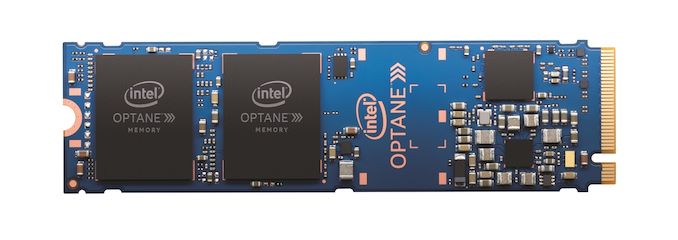
It appears that the end may be in sight for Intel’s beleaguered Optane memory business. Tucked inside a brutal Q2’2022 earnings release for the company (more on that a bit later today) is a very curious statement in a section talking about non-GAAP adjustments: In Q2 2022, we initiated the winding down of our Intel Optane memory business. As well, Intel’s earnings report also notes that the company is taking a $559 Million “Optane inventory impairment” charge this quarter.
Taking these items at face value, it would seem that Intel is preparing to shut down its Optane memory business and development of associated 3D XPoint technology. To be sure, there is a high degree of nuance here around the Optane name and product lines – which is why we’re looking for clarification from Intel – as Intel has several Optane products, including “Optane memory” “Optane persistent memory” and “Optane SSDs”. None the less, within Intel’s previous earnings releases and other financial documents, the complete Optane business unit has traditionally been referred to as their “Optane memory business,” so it would appear that Intel is indeed winding down the complete Optane business unit, and not just the Optane Memory product.
Update: 6:40pm ET
Following our request, Intel has sent out a short statement on the Optane wind-down. While not offering much in the way of further details on Intel's exit, it does confirm that Intel is indeed exiting the entire Optane business.
We continue to rationalize our portfolio in support of our IDM 2.0 strategy. This includes evaluating divesting businesses that are either not sufficiently profitable or not core to our strategic objectives. After careful consideration, Intel plans to cease future product development within its Optane business. We are committed to supporting Optane customers through the transition.
Intel's associated 10-Q filing also contains a short statement on the matter.
In the second quarter of 2022, we initiated the wind-down of our Intel Optane memory business, which is part of our DCAI operating segment. While Intel Optane is a leading technology, it was not aligned to our strategic priorities. Separately, we continue to embrace the CXL standard. As a result, we recognized an inventory impairment of $559 million in Cost of sales on the Consolidated Condensed Statements of Income in the second quarter of 2022. The impairment charge is recognized as a Corporate charge in the "all other" category presented above. As we wind down the Intel Optane business, we expect to continue to meet existing customer commitments.
First announced by Intel in 2015, the company’s 3D XPoint memory technology was pitched as the convergence between DRAM and solid state storage. The unique, bit-addressable memory uses phase change technology to store data, rather than trapping electrons like NAND technology. As a result, 3D XPoint offers incredibly high endurance – on the order of millions of writes – as well as very high random read and write performance since its data doesn’t have to be organized into relatively large blocks.
Intel, in turn, used 3D XPoint as the basis of two product lineups. For its datacenter customers, it offered Optane Persistent Memory, which packaged 3D XPoint into DIMMs as a partial replacement for traditional DRAMs. Optane DIMMs offered greater bit density than DRAM, and combined with its persistent, non-volatile nature made for an interesting offering for systems that needed massive working memory sets and could benefit from its non-volatile nature, such as database servers. Meanwhile Intel also used 3D XPoint as the basis of several storage products, including high-performance SSDs for the server and client market, and as a smaller high-speed cache for use with slower NAND SSDs.
3D XPoint’s unique attributes have also been a challenge for Intel since the technology launched, however. Despite being designed for scalability via layer stacking, 3D XPoint manufacturing costs have continued to be higher than NAND on a per-bit basis, making the tech significantly more expensive than even higher-performance SSDs. Meanwhile Optane DIMMs, while filling a unique niche, were equally as expensive and offered slower transfer rates than DRAM. So, despite Intel’s efforts to offer a product that could crossover the two product spaces, for workloads that don’t benefit from the technology’s unique abilities, 3D XPoint ended up being neither as good as DRAM or NAND in their respective tasks – making Optane products a hard sell.
As a result, Intel has been losing money on its Optane business for most (if not all) of its lifetime, including hundreds of millions of dollars in 2020. Intel does not break out Optane revenue information on a regular basis, but on the one-off occasions where they have published those numbers, they have been well in the red on an operating income basis. As well, reports from Blocks & Files have claimed that Intel is sitting on a significant oversupply of 3D XPoint chips – on the order of two years’ of inventory as of earlier this year. All of which underscores the difficulty Intel has encountered in selling Optane products, and adding to the cost of a write-down/write-off, which Intel is doing today with their $559M Optane impairment charge.
Consequently, a potential wind-down for Optane /3D XPoint has been in the tea leaves for a while now, and Intel has been taking steps to alter or curtail the business. Most notably, the dissolution of the Intel/Micron IMFT joint venture left Micron with possession of the sole production fab for 3D XPoint, all the while Micron abandoned their own 3D XPoint plans. And after producing 3D XPoint memory into 2021, Micron eventually sold the fab to Texas Instruments for other uses. Since then, Intel has not had access to a high volume fab for 3D XPoint – though if the inventory reports are true, they haven’t needed to produce more of the memory in quite some time.
Meanwhile on the product side of matters, winding-down the Optane business follows Intel’s earlier retreat from the client storage market. While the company has released two generations of Optane products for the datacenter market, it never released a second generation of consumer products (e.g. Optane 905P). And, having sold their NAND business to SK Hynix (which now operates as Solidigm), Intel no longer produces other types of client storage. So retiring the remaining datacenter products is the logical next step, albeit an unfortunate one.
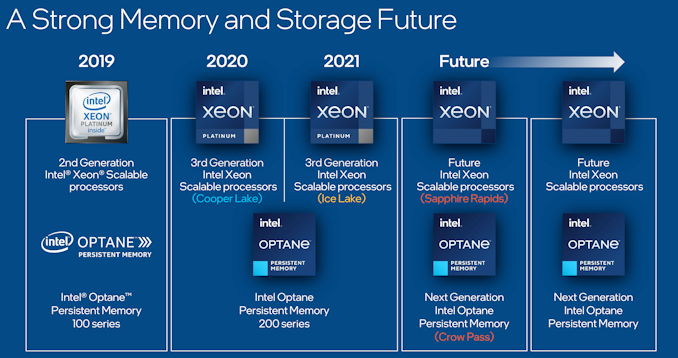
Intel's Former Optane Persistent Memory Roadmap: What WIll Never Be
Overall, Intel has opted to wind-down the Optane/3D XPoint business at a critical juncture for the company. With their Sapphire Rapids Xeon CPUs launching this year, Intel was previously scheduled to launch a matching third generation of Optane products. The most important of these was to be their “Crow Pass” 3rd generation persistent DIMMs, which among other things would update the Optane DIMM technology to use a DDR5 interface. While development of Crow Pass is presumably complete or nearly complete at this point (given Intel’s development schedule and Sapphire Rapids delays), actually launching and supporting the product would still incur significant up-front and long-term costs, as well as requiring Intel to support the technology for another generation. Giving Intel a strong incentive to finally take an exit on the money-losing business unit.
In lieu of Optane persistent memory, Intel’s official strategy is to pivot towards CXL memory technology (CXL.mem), which allows attaching volatile and non-volatile memory to a CPU over a CXL-capable PCIe bus. This would accomplish many of the same goals as Optane (non-volatile memory, large capacities) without the costs of developing an entirely separate memory technology. Sapphire Rapids, in turn will be Intel’s first CPU to support CXL, and the overall technology has a much broader industry backing.
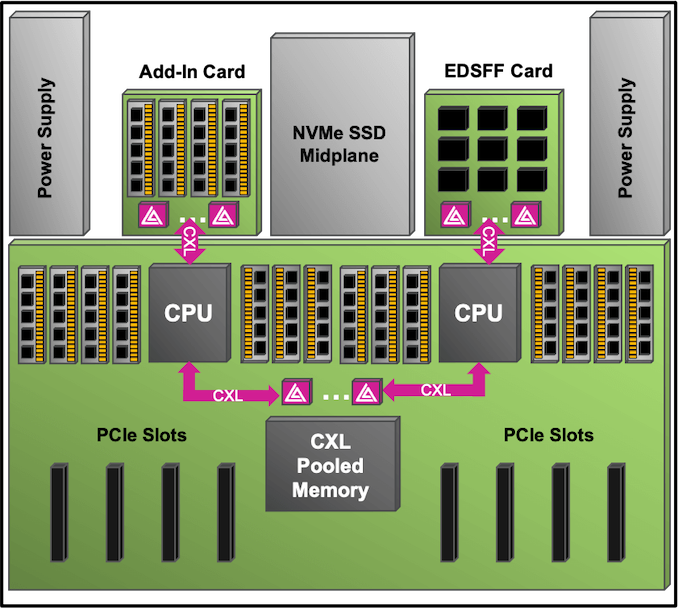
AsteraLabs: CXL Memory Topology
Still, Intel’s retirement of Optane/3D XPoint marks an unfortunate end of an interesting product lineup. 3D XPoint DIMMs were a novel idea even if they didn’t quite work out, and 3D XPoint made for ridiculously fast SSDs thanks to its massive random I/O advantage – and that’s a feature it doesn’t look like any other SSD vendor is going to be able to fully replicate any time soon. So for the solid state storage market, this marks the end of an era.


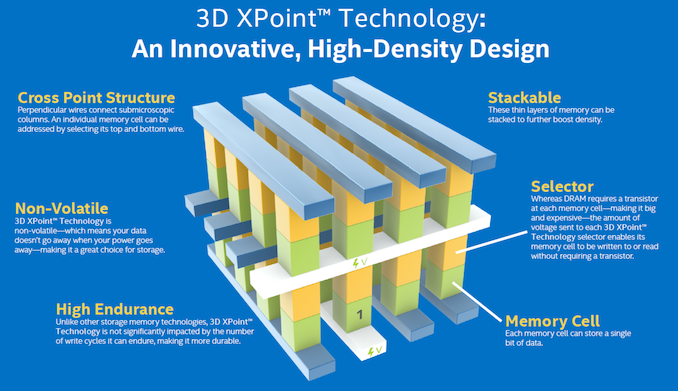
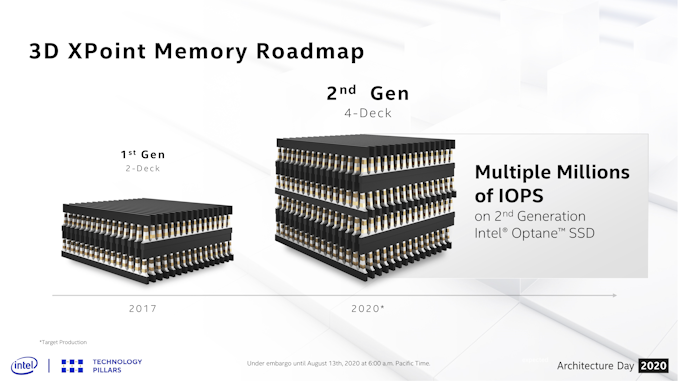








70 Comments
View All Comments
edzieba - Friday, July 29, 2022 - link
A shame to see the Chalcogenide process die such an early death, after decades of Micron trying their hardest to prevent it even getting off the ground the first place (all the shenanigans around the Ovonics patents and avoiding paying royalties, and waiting until ECD could be killed off before unveiling 3D X-point).zanon - Friday, July 29, 2022 - link
That's a real shame. I wonder how much of it was due to typical reviews and advertising completely failing to highlight what a difference Optane was. The normal benchmarks tend to be high queue depth and large blocks, and no indication of 95/97/99/99.9 percentile latency spikes. I've tested supposedly top tier NVMe "very fast" drives and seen the performance just tank miserably in a variety of workloads which don't match very well. I don't think the price differential had to be as high as it was if it had scaled enough.I do think Intel/Micron mismanaged the tech though, not an uncommon pattern for Intel at all. They needed more partners and production, to get it to be something lots of places could produce and use standard and get at most a small royalty. Intel wanted their typical vertical lock-in which meant it'd only ever be ultra high end which meant lower volume and death spiral commenced. Stinks though, I'd always hoped one day that kind of consistency would be there for us all in volume.
mode_13h - Friday, July 29, 2022 - link
Do we really think 3D XPoint simply lacks the potential ever to compete with NAND in bits/$? Or was Intel simply unwilling to invest the money to make it competitive, due to its poor market performance (which seems largely due to far fewer bits/$)?Also, I think the article could've focused more on the amount of software investment required (by Intel & others) to truly take advantage of Optane DIMMs.
thestryker - Friday, July 29, 2022 - link
With CXL coming their hard shift to Optane DIMMs rather than expanding the storage side is baffling to me. Second generation 3D XPoint had twice as many layers as the first, and if they could have doubled it again the possibility of getting storage down in price to a reasonable premium over NAND was there.It really seems like a combination of shifting the market wrong and not wanting to spend the money to continue the project.
JayNor - Saturday, July 30, 2022 - link
The Aurora project reportedly includes Optane. It isn't clear if it was waiting for gen3 Optane with a DDR5 controller, or if was to be integrated into some DAOS storage system with gen2.There were other testimonials by BSC, Meta, Alibaba that said it was the only viable solution for their HPC and storage needs. I believe for BSC it was the power vs DDR.
The initial performance leaked results from the gen3/DDR5 indicated it wasn't ready. I wonder if now they'll remove Optane support from Emerald Rapids.
There were also reports of new Optane packaging associated with the cxl memory pools that could have made an interesting product.
You'd think with the wide ucie and Intel's advanced packaging plans, they could have found an co-packaged chiplet solution that improved the yields.
hanselltc - Monday, August 1, 2022 - link
Optane as memory instead of storage always seemed a dumb idea to me. WTF is persistent memory good for when the systems it would've went into are made to have as little down time as possible? What good even is persistent memory, moving stuff from ssd into ram is not that slow, while optane compared to ram was always way slower. On storage it had a future, on memory it might have outside of DC, but intel went headfirst down the goldengate.back2future - Monday, August 1, 2022 - link
one financial reason, cost/GB (additional level 3-4) memory, maybe (previously) availability, compatibility with system changes, and some kind of 'out of system' backup with hot pluggingname99 - Monday, August 1, 2022 - link
Your response shows why Optane was doomed from the start -- because people inside Intel, like you, can't see beyond the server.Imagine something like Optane in an Apple watch, serving as both DRAM and storage. Apple watch can live with the slower access because it has large caches, and it appreciates both the smaller package size (just one chip, not DRAM and flash) and lower energy/persistence compared to DRAM.
But that would have required
(a) Intel being willing to see this as not just as Intel-Xeon-Platinum exclusive AND
(b) Intel being willing to make whatever changes Apple would require to make it practical (like maybe a smaller chip to match Apple watch's limited storage).
Optane died because the people in charge of it were convinced the only use case that mattered was running SAP in-memory, and were too damn stupid/ignorant to understand that most computing has moved way beyond that sort of world!
Tomatotech - Tuesday, August 2, 2022 - link
Interesting idea about Optane in an Apple Watch (or iPhone or other mobile device). I certainly never thought of that.However, Apple almost certainly has looked into it. They have trillions in cash and a history of scooping up any tech that can bring even a minor edge to their devices. The fact they haven’t put Optane into their devices suggests they found it brings little to no benefit. That could be in terms of power consumption vs speed, even on the high end, or whatever their criteria is.
name99 - Wednesday, August 3, 2022 - link
Apple HAVE looked into it. There are a bunch of Apple patents about how to modify aspects of the SoC to work with a RAM that's slower than normal DRAM. (The patents don't say Optane but they are about a RAM that's slower than DRAM and persistent; my guess is that the work was generic to cover Optane and/or MRAM and even Nantero if that ever becomes real.)But Intel had their heart set on Optane being a "differentiator" that would force you to buy a Xeon Platinum because that was the *only* way you could get to use Optane DIMMs...
It's certainly possible that Apple's conclusion after a few years of work (the patents span about three years) was that they could not get it to work, either technically or financially. But I suspect it's more likely that Intel was just not willing to play ball at first, and by the time they perhaps were willing, by crunch time, Apple was no longer interested. After all why should they be? Wait a few years and MRAM will fill the same niche (for Apple, anyway) without having to put up with Intel's prima donna attitude.
Why do I blame Intel? Well look at the point I made – Optane is potentially viable in many UNUSUAL use cases. But Intel did nothing to even attempt to cultivate these. Compare with, eg, Toshiba's 1.8" drive. Toshiba had no idea what such a small and slow drive might be useful for, but they shopped it around and Apple bit, using it for the first iPod.
https://whynow.co.uk/read/the-ipod-died-lets-bring...